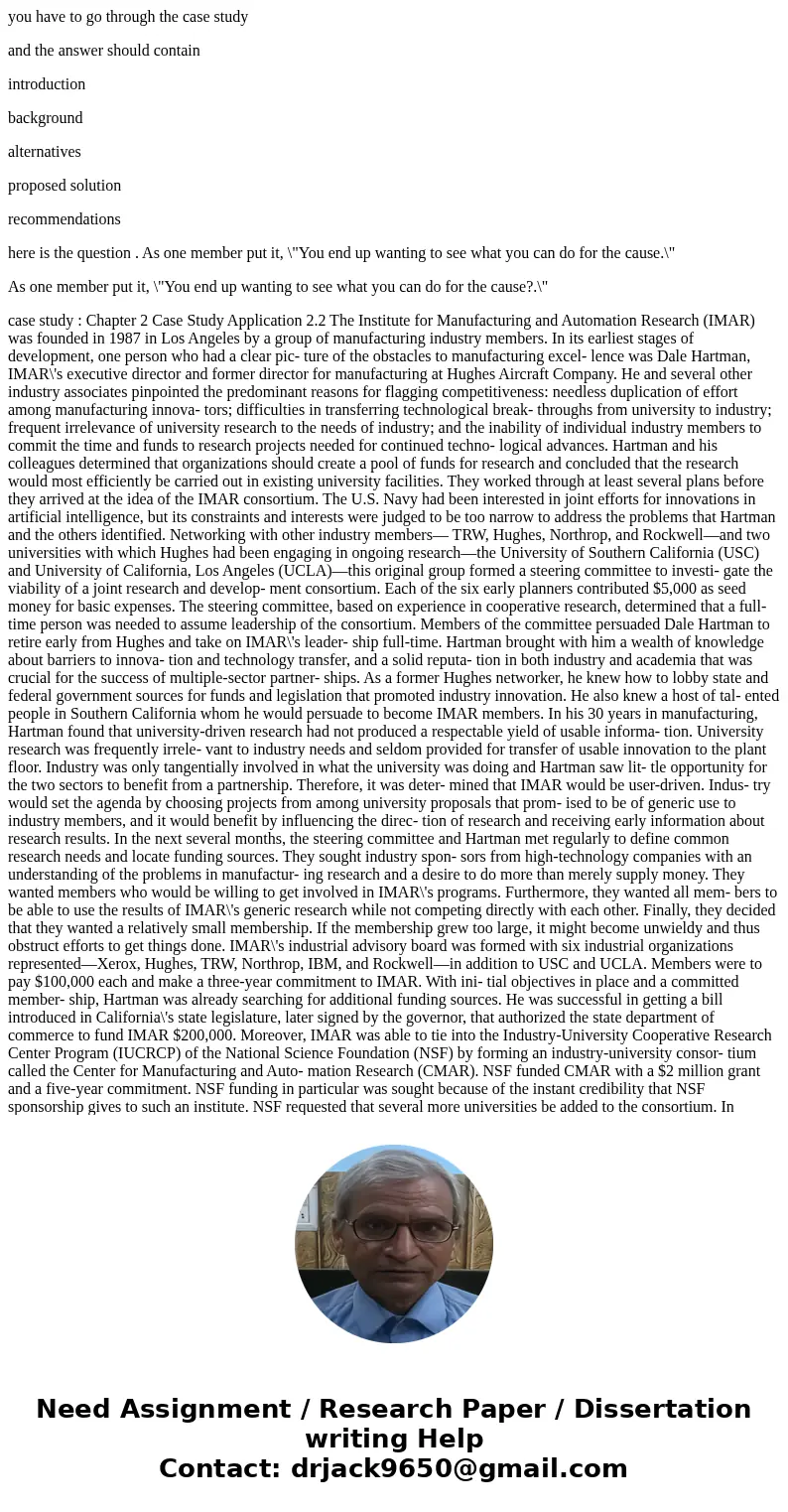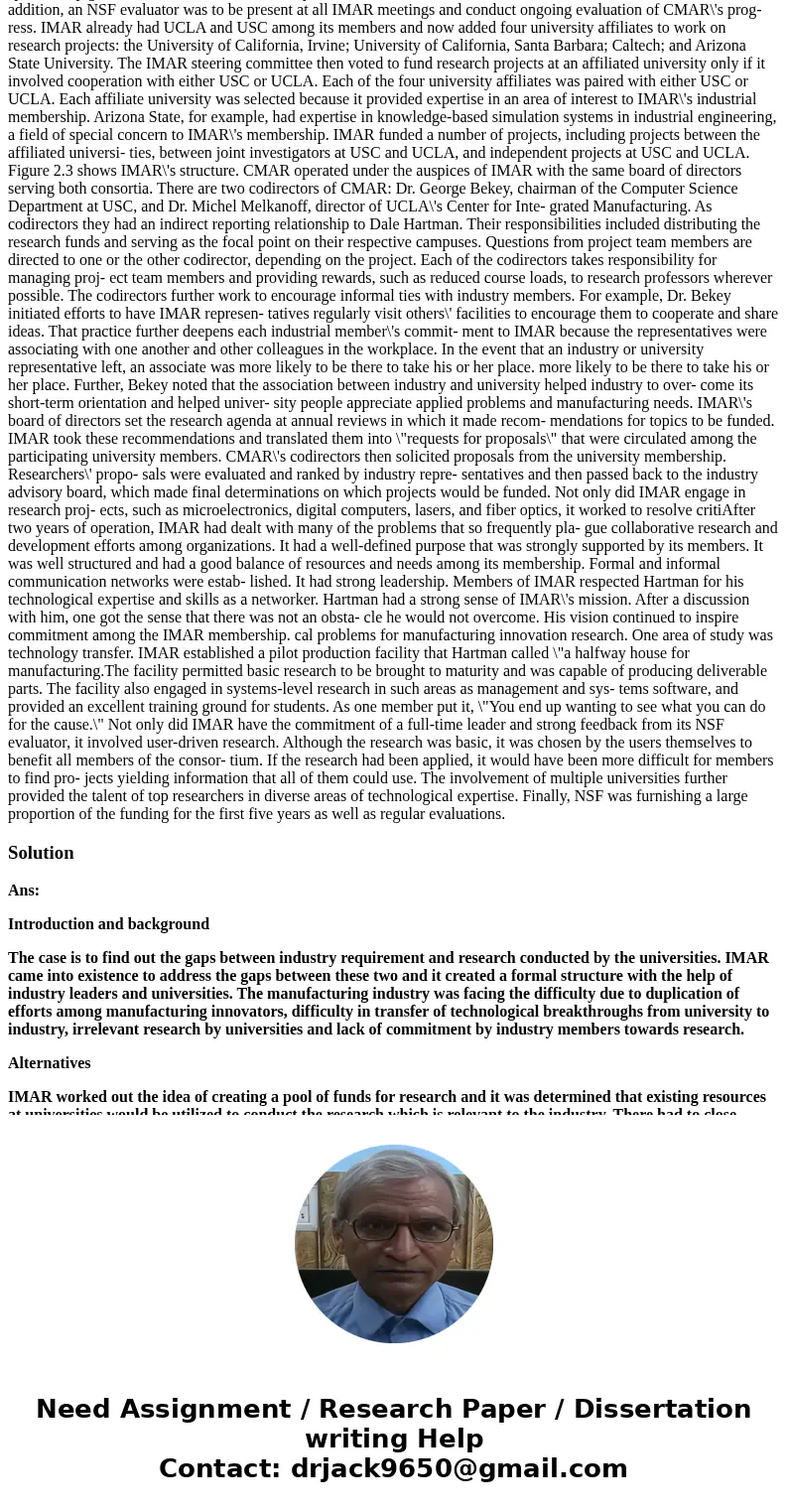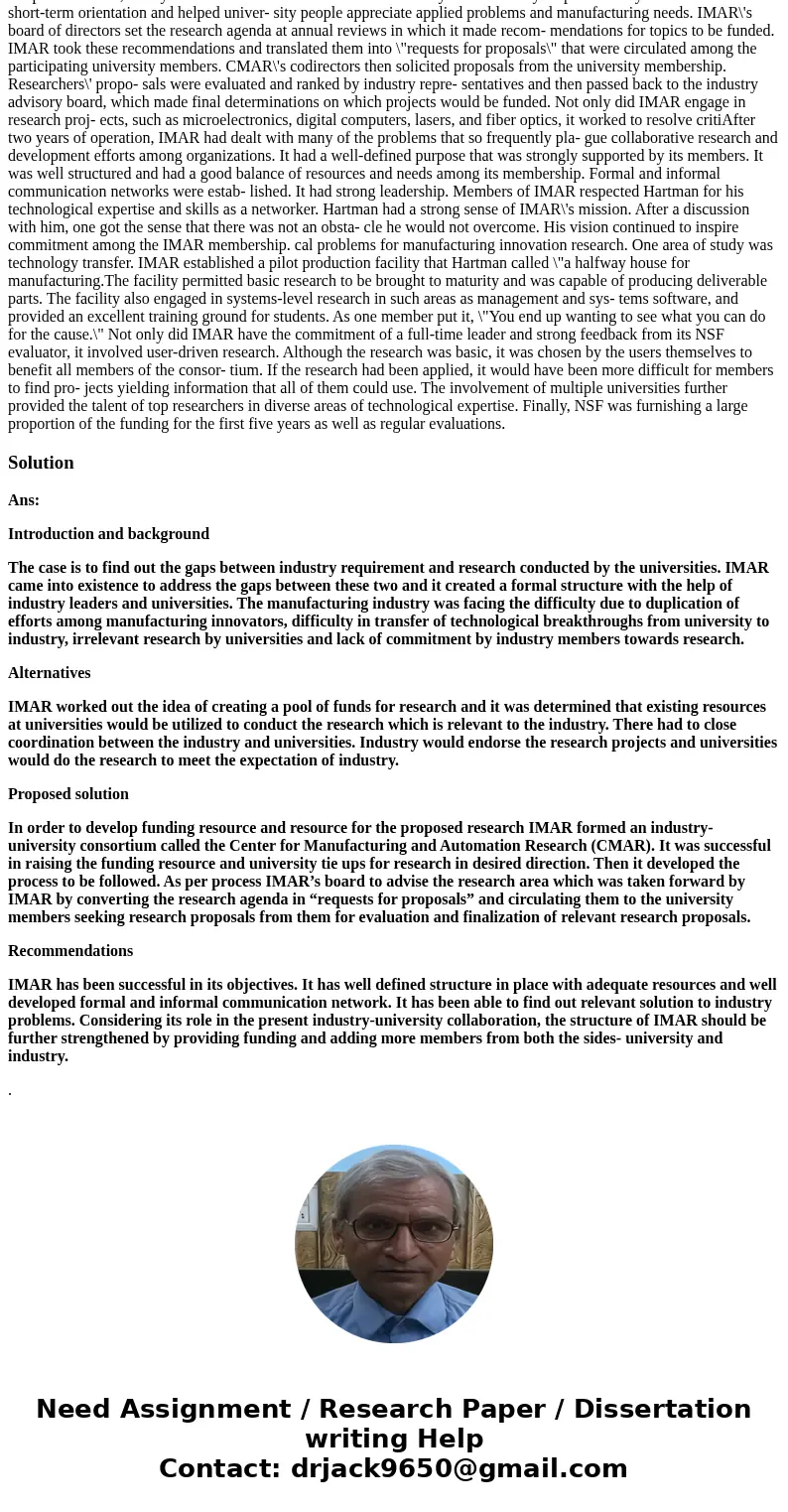you have to go through the case study and the answer should
you have to go through the case study
and the answer should contain
introduction
background
alternatives
proposed solution
recommendations
here is the question . As one member put it, \"You end up wanting to see what you can do for the cause.\"
As one member put it, \"You end up wanting to see what you can do for the cause?.\"
case study : Chapter 2 Case Study Application 2.2 The Institute for Manufacturing and Automation Research (IMAR) was founded in 1987 in Los Angeles by a group of manufacturing industry members. In its earliest stages of development, one person who had a clear pic- ture of the obstacles to manufacturing excel- lence was Dale Hartman, IMAR\'s executive director and former director for manufacturing at Hughes Aircraft Company. He and several other industry associates pinpointed the predominant reasons for flagging competitiveness: needless duplication of effort among manufacturing innova- tors; difficulties in transferring technological break- throughs from university to industry; frequent irrelevance of university research to the needs of industry; and the inability of individual industry members to commit the time and funds to research projects needed for continued techno- logical advances. Hartman and his colleagues determined that organizations should create a pool of funds for research and concluded that the research would most efficiently be carried out in existing university facilities. They worked through at least several plans before they arrived at the idea of the IMAR consortium. The U.S. Navy had been interested in joint efforts for innovations in artificial intelligence, but its constraints and interests were judged to be too narrow to address the problems that Hartman and the others identified. Networking with other industry members— TRW, Hughes, Northrop, and Rockwell—and two universities with which Hughes had been engaging in ongoing research—the University of Southern California (USC) and University of California, Los Angeles (UCLA)—this original group formed a steering committee to investi- gate the viability of a joint research and develop- ment consortium. Each of the six early planners contributed $5,000 as seed money for basic expenses. The steering committee, based on experience in cooperative research, determined that a full-time person was needed to assume leadership of the consortium. Members of the committee persuaded Dale Hartman to retire early from Hughes and take on IMAR\'s leader- ship full-time. Hartman brought with him a wealth of knowledge about barriers to innova- tion and technology transfer, and a solid reputa- tion in both industry and academia that was crucial for the success of multiple-sector partner- ships. As a former Hughes networker, he knew how to lobby state and federal government sources for funds and legislation that promoted industry innovation. He also knew a host of tal- ented people in Southern California whom he would persuade to become IMAR members. In his 30 years in manufacturing, Hartman found that university-driven research had not produced a respectable yield of usable informa- tion. University research was frequently irrele- vant to industry needs and seldom provided for transfer of usable innovation to the plant floor. Industry was only tangentially involved in what the university was doing and Hartman saw lit- tle opportunity for the two sectors to benefit from a partnership. Therefore, it was deter- mined that IMAR would be user-driven. Indus- try would set the agenda by choosing projects from among university proposals that prom- ised to be of generic use to industry members, and it would benefit by influencing the direc- tion of research and receiving early information about research results. In the next several months, the steering committee and Hartman met regularly to define common research needs and locate funding sources. They sought industry spon- sors from high-technology companies with an understanding of the problems in manufactur- ing research and a desire to do more than merely supply money. They wanted members who would be willing to get involved in IMAR\'s programs. Furthermore, they wanted all mem- bers to be able to use the results of IMAR\'s generic research while not competing directly with each other. Finally, they decided that they wanted a relatively small membership. If the membership grew too large, it might become unwieldy and thus obstruct efforts to get things done. IMAR\'s industrial advisory board was formed with six industrial organizations represented—Xerox, Hughes, TRW, Northrop, IBM, and Rockwell—in addition to USC and UCLA. Members were to pay $100,000 each and make a three-year commitment to IMAR. With ini- tial objectives in place and a committed member- ship, Hartman was already searching for additional funding sources. He was successful in getting a bill introduced in California\'s state legislature, later signed by the governor, that authorized the state department of commerce to fund IMAR $200,000. Moreover, IMAR was able to tie into the Industry-University Cooperative Research Center Program (IUCRCP) of the National Science Foundation (NSF) by forming an industry-university consor- tium called the Center for Manufacturing and Auto- mation Research (CMAR). NSF funded CMAR with a $2 million grant and a five-year commitment. NSF funding in particular was sought because of the instant credibility that NSF sponsorship gives to such an institute. NSF requested that several more universities be added to the consortium. In addition, an NSF evaluator was to be present at all IMAR meetings and conduct ongoing evaluation of CMAR\'s prog- ress. IMAR already had UCLA and USC among its members and now added four university affiliates to work on research projects: the University of California, Irvine; University of California, Santa Barbara; Caltech; and Arizona State University. The IMAR steering committee then voted to fund research projects at an affiliated university only if it involved cooperation with either USC or UCLA. Each of the four university affiliates was paired with either USC or UCLA. Each affiliate university was selected because it provided expertise in an area of interest to IMAR\'s industrial membership. Arizona State, for example, had expertise in knowledge-based simulation systems in industrial engineering, a field of special concern to IMAR\'s membership. IMAR funded a number of projects, including projects between the affiliated universi- ties, between joint investigators at USC and UCLA, and independent projects at USC and UCLA. Figure 2.3 shows IMAR\'s structure. CMAR operated under the auspices of IMAR with the same board of directors serving both consortia. There are two codirectors of CMAR: Dr. George Bekey, chairman of the Computer Science Department at USC, and Dr. Michel Melkanoff, director of UCLA\'s Center for Inte- grated Manufacturing. As codirectors they had an indirect reporting relationship to Dale Hartman. Their responsibilities included distributing the research funds and serving as the focal point on their respective campuses. Questions from project team members are directed to one or the other codirector, depending on the project. Each of the codirectors takes responsibility for managing proj- ect team members and providing rewards, such as reduced course loads, to research professors wherever possible. The codirectors further work to encourage informal ties with industry members. For example, Dr. Bekey initiated efforts to have IMAR represen- tatives regularly visit others\' facilities to encourage them to cooperate and share ideas. That practice further deepens each industrial member\'s commit- ment to IMAR because the representatives were associating with one another and other colleagues in the workplace. In the event that an industry or university representative left, an associate was more likely to be there to take his or her place. more likely to be there to take his or her place. Further, Bekey noted that the association between industry and university helped industry to over- come its short-term orientation and helped univer- sity people appreciate applied problems and manufacturing needs. IMAR\'s board of directors set the research agenda at annual reviews in which it made recom- mendations for topics to be funded. IMAR took these recommendations and translated them into \"requests for proposals\" that were circulated among the participating university members. CMAR\'s codirectors then solicited proposals from the university membership. Researchers\' propo- sals were evaluated and ranked by industry repre- sentatives and then passed back to the industry advisory board, which made final determinations on which projects would be funded. Not only did IMAR engage in research proj- ects, such as microelectronics, digital computers, lasers, and fiber optics, it worked to resolve critiAfter two years of operation, IMAR had dealt with many of the problems that so frequently pla- gue collaborative research and development efforts among organizations. It had a well-defined purpose that was strongly supported by its members. It was well structured and had a good balance of resources and needs among its membership. Formal and informal communication networks were estab- lished. It had strong leadership. Members of IMAR respected Hartman for his technological expertise and skills as a networker. Hartman had a strong sense of IMAR\'s mission. After a discussion with him, one got the sense that there was not an obsta- cle he would not overcome. His vision continued to inspire commitment among the IMAR membership. cal problems for manufacturing innovation research. One area of study was technology transfer. IMAR established a pilot production facility that Hartman called \"a halfway house for manufacturing.The facility permitted basic research to be brought to maturity and was capable of producing deliverable parts. The facility also engaged in systems-level research in such areas as management and sys- tems software, and provided an excellent training ground for students. As one member put it, \"You end up wanting to see what you can do for the cause.\" Not only did IMAR have the commitment of a full-time leader and strong feedback from its NSF evaluator, it involved user-driven research. Although the research was basic, it was chosen by the users themselves to benefit all members of the consor- tium. If the research had been applied, it would have been more difficult for members to find pro- jects yielding information that all of them could use. The involvement of multiple universities further provided the talent of top researchers in diverse areas of technological expertise. Finally, NSF was furnishing a large proportion of the funding for the first five years as well as regular evaluations.
Solution
Ans:
Introduction and background
The case is to find out the gaps between industry requirement and research conducted by the universities. IMAR came into existence to address the gaps between these two and it created a formal structure with the help of industry leaders and universities. The manufacturing industry was facing the difficulty due to duplication of efforts among manufacturing innovators, difficulty in transfer of technological breakthroughs from university to industry, irrelevant research by universities and lack of commitment by industry members towards research.
Alternatives
IMAR worked out the idea of creating a pool of funds for research and it was determined that existing resources at universities would be utilized to conduct the research which is relevant to the industry. There had to close coordination between the industry and universities. Industry would endorse the research projects and universities would do the research to meet the expectation of industry.
Proposed solution
In order to develop funding resource and resource for the proposed research IMAR formed an industry- university consortium called the Center for Manufacturing and Automation Research (CMAR). It was successful in raising the funding resource and university tie ups for research in desired direction. Then it developed the process to be followed. As per process IMAR’s board to advise the research area which was taken forward by IMAR by converting the research agenda in “requests for proposals” and circulating them to the university members seeking research proposals from them for evaluation and finalization of relevant research proposals.
Recommendations
IMAR has been successful in its objectives. It has well defined structure in place with adequate resources and well developed formal and informal communication network. It has been able to find out relevant solution to industry problems. Considering its role in the present industry-university collaboration, the structure of IMAR should be further strengthened by providing funding and adding more members from both the sides- university and industry.
.



 Homework Sourse
Homework Sourse